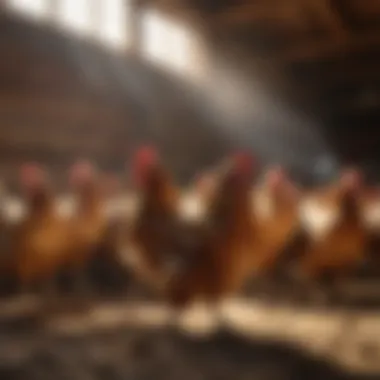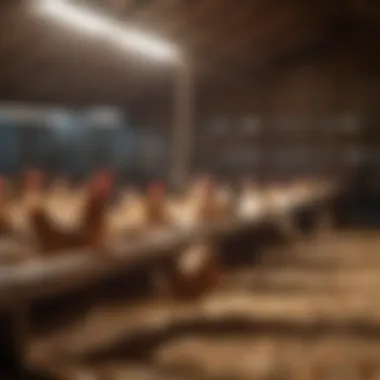Understanding Chicken Coop Light Fixtures for Better Poultry Management


Intro
Creating a conducive environment in a chicken coop is crucial for the optimal health and productivity of poultry. One of the key elements to achieve this is through proper lighting. Many poultry owners might not realize the impact that light fixtures can have on their chickens. This article aims to unpack these elements and explore the different types of light fixtures applicable to a chicken coop. We will also focus on installation tips, energy efficiency, and how these lights contribute to enhanced poultry management.
Latest Trends in Agriculture
Overview of Current Trends
The agricultural landscape is evolving with several modern trends shaping the way poultry is managed. Among these trends, there is a marked shift towards integrated practices that emphasize animal welfare. Lighting in chicken coops plays a pivotal role here. Many farmers are opting for advanced lighting systems which can be adjusted to mimic natural sunlight patterns. This approach not only aligns the chickens’ lifecycle but also influences their behavior, ultimately leading to improved egg production and growth rates.
Impact of Technology on Farming Practices
Technology has become a cornerstone in improving farming practices. Smart lighting solutions are becoming commonplace. These fixtures can be programmed to change brightness and duration, optimizing the chicken's exposure to light based on various factors such as age and breeding cycle. This is done through the use of timers and sensors that monitor ecological conditions. The integration of automation translates into more productive farming and a significant reduction in manual labor.
Sustainable Practices: Towards a Greener Future
Importance of Sustainability in Agriculture
Sustainability in agriculture is not just a buzzword; it represents a necessary pathway toward ensuring that food production meets present and future demands without harming the environment. In the context of chicken coops, energy-efficient light fixtures contribute to sustainable practices. By utilizing LED lights, which consume significantly less energy than traditional bulbs, farmers can reduce their carbon footprint while also decreasing operational costs.
Methods for Sustainable Farming
Incorporating sustainable lighting solutions is part of a larger strategy for environmentally friendly farming. Some methods that poultry owners can consider include:
- Using LED Lights: These lights last longer and use less energy.
- Solar Lighting: For those in areas with ample sunlight, solar-powered lights reduce dependency on grid electricity.
- Light Management Technology: This ensures optimal light exposure, minimizing waste and enhancing productivity.
The End
Understanding the role of light fixtures in a chicken coop is essential for optimal poultry management. Proper lighting contributes to better growth and productivity while also promoting sustainable farming practices. Through the adoption of current trends and integration of technology, poultry farmers can enhance not only the welfare of their chickens but also their overall management practices.
Prelims to Chicken Coop Lighting
Effective lighting is critical in a chicken coop. It can influence the overall health and productivity of poultry. Chickens, like all animals, respond to their environment. Therefore, understanding the nuances of chicken coop lighting can enhance both animal welfare and productivity.
Good lighting ensures that chickens can see and move freely in their environment. This reduces stress and promotes better well-being. Moreover, proper illumination can assist in regulating the birds' breeding cycles and laying patterns. When managed wisely, lighting can become a tool that poultry farmers can employ for success.
Importance of Lighting in Poultry Management
Lighting conditions inside a chicken coop affects the behavior and physiology of the birds. When chickens receive optimal lighting, their growth rates increase. This supports a more efficient feed-to-meat conversion. Moreover, well-lit environments can reduce pecking among birds, which minimizes injuries and promotes a calm atmosphere.
Some studies indicate that light exposure can enhance egg production. A carefully designed light schedule can help trigger the reproductive hormones essential for egg laying. If chickens experience extended daylight hours, it may lead to increased egg output, which is a fundamental factor for egg farmers.
"Managing light can minimize stress and optimize productivity in poultry farming."
In addition, proper lighting can help with the management of coop health. A well-lit coop enables farmers to observe their birds more easily for signs of illness or distress. Early detection is vital in preventing the spread of disease within a flock.
General Principles of Poultry Lighting
When considering poultry lighting, the spectrum, intensity, and duration of light are integral elements. Chicken vision differs from humans, and they are particularly sensitive to certain wavelengths of light. Hence, selecting the right type of light can affect how chickens perceive their environment.
- Light Spectrum: Chickens are sensitive to blue and green light, which can stimulate their activity levels. Understanding this can lead to more strategic lighting choices.
- Light Intensity: It is important to provide adequate lighting, typically around 10-20 lux for general housing and up to 50 lux for areas requiring more clarity, such as feeding zones.
- Light Duration: A consistent light-dark cycle mimics natural conditions. For laying hens, a schedule of 14-16 hours of light followed by 8-10 hours of darkness tends to be effective.
In summary, knowledge and application of proper lighting principles can greatly elevate poultry management practices. This understanding is not only beneficial for growth and production but also improves the overall ecosystem of the chicken coop.
Types of Chicken Coop Light Fixtures
The selection of light fixtures in a chicken coop plays a crucial role in enhancing the living conditions for poultry. Proper lighting not only influences the behavior and health of chickens but also impacts productivity. Each type of light fixture offers unique features and advantages. Understanding these differences is vital for poultry owners seeking to optimize their facilities. Here, we will examine natural and artificial lighting options in detail, assessing their roles and benefits.
Natural Lighting Solutions


Natural lighting is beneficial for poultry. It aligns with the chickens' natural circadian rhythm. Sunlight exposure promotes behavior typical of outdoor life. This can lead to reduced stress and improved mental well-being. Many chicken coops benefit from windows or skylights. These openings allow sunlight to enter throughout the day. Careful placement is important to protect birds from overheating or adverse weather.
Natural light can also encourage healthy behaviors, such as nesting and foraging. Implementing design features that capitalize on sunlight is a key strategy for any poultry owner. It is also cost-effective. Natural lighting requires no energy consumption. This allows for a more sustainable approach in managing chicken coops.
Artificial Lighting Options
Artificial lighting is often necessary, especially during winter months or in regions with long nights. The use of electric light extends the day length and helps maintain consistent egg production. Different types of artificial lighting fixtures provide various advantages. Below, we delve into the most commonly used options in chicken coops.
LED Lighting
LED lighting is a frontrunner in modern chicken coop lighting solutions. One key characteristic of LED lights is energy efficiency. They consume significantly less energy than traditional light bulbs. This translates to lower electricity bills for poultry owners. Another advantage is their long lifespan. LEDs can last up to 25 times longer than incandescent bulbs.
An important feature of LED lighting is its spectrum flexibility. This means owners can choose specific wavelengths favorable for chicken growth. Besides, LEDs produce minimal heat, reducing the risk of overheating the coop and harming the birds.
However, the initial cost of LED lighting can be higher compared to old-style bulbs. Nonetheless, the long-term savings often justify the investment.
Incandescent Bulbs
Incandescent bulbs were previously the standard for coop lighting. They are inexpensive and widely available. Their warm light is comforting to both chickens and owners. One notable feature is the ability to produce a bright, focused light.
Despite these benefits, incandescent bulbs have significant drawbacks. They are not energy-efficient. These bulbs consume more power and need replacement more often, leading to higher ongoing costs. Additionally, they produce excessive heat, which can be a concern in warmer weather.
Fluorescent Lights
Fluorescent lights offer a good compromise between energy efficiency and brightness. These lights use less electricity than incandescent bulbs. Their light is soft and covers larger areas, making them effective for bigger coops. A key characteristic is their ability to provide consistent illumination, crucial during the darker months.
One disadvantage to consider is their sensitivity to cold temperatures. In very low temperatures, fluorescent lights may not function optimally. This makes them less reliable in certain regions during winter.
Halogen Lights
Halogen lights are another popular artificial lighting option. They are a type of incandescent bulb but more efficient. One significant aspect of halogen lights is their ability to reach full brightness almost instantly. This is especially useful when immediate lighting is needed, such as in emergency situations.
Halogen lights also produce high-quality light that can positively affect poultry behavior. However, they generate more heat than other light fixtures, which can increase coop temperatures uncomfortably. Consequently, proper placement and management are necessary to balance their benefits and drawbacks.
In summary, choosing the right type of light fixture is integral to effective poultry management. Each light type contributes uniquely to a chicken coop's environment, and understanding these differences helps in making informed decisions.
Selecting the Right Light Fixture
Selecting the right light fixture for a chicken coop is a crucial step in poultry management. Appropriate lighting can significantly affect chicken behavior, health, and productivity. Therefore, understanding specific factors and needs can help ensure that both the birds and their environment thrive. This section will guide you through essential considerations when choosing light fixtures, ensuring they serve the intended purpose effectively.
Factors to Consider
Coop Size and Structure
The size and structure of your chicken coop play an important role in light fixture selection. A larger coop may require multiple fixtures to ensure uniform light distribution. Adequate lighting in every corner is necessary to reduce stress and promote natural behaviors among the chickens. Additionally, the structure, whether it is wooden or metal, can influence fixture placement.
A key characteristic here is the coop layout. This layout dictates how light penetrates the space and how fixtures can be oriented. Choosing fixtures that are adaptable to the coop’s design can ensure longevity and efficiency. For instance, a coop with high ceilings may benefit from pendant fixtures for broader light coverage, while smaller structures might use wall-mounted units effectively. The overall objective is to enhance the living environment through optimal light placement.
Energy Efficiency
Energy efficiency is another significant aspect when selecting light fixtures. Energy-efficient lighting, such as LED options, can greatly reduce electricity costs over time. These fixtures provide high lumen output while consuming less energy compared to traditional bulbs.
An essential feature of energy efficiency is the long lifespan of such bulbs, which can last up to 25,000 hours. This longevity means fewer replacements and less waste, which is beneficial for both budget and the environment. However, upfront costs may be higher for energy-efficient fixtures, making an initial investment worthwhile for long-term savings.
Light Intensity and Spectrum
Light intensity and spectrum are critical in promoting hen welfare and productivity. Chickens respond variably to different intensities of light. Bright, intense light can stimulate activity, while subdued tones may create a calmer environment.
The spectrum of light also plays a role. Chickens can perceive colors, and full-spectrum lights can mimic natural daylight, enhancing their natural cycles and behaviors. It is essential to choose light fixtures that can be adjusted to fit various needs. For instance, a dimmable light fixture allows for flexibility in managing light intensity based on the time of day or specific requirements.
Durability and Resistance to Moisture


Durability and resistance to moisture further influence light fixture selection. Chicken coops often contain high humidity levels, especially if housing is not properly ventilated. Selecting fixtures that are waterproof or weather-resistant can prevent moisture damage and electrical hazards.
A key characteristic of sturdy light fixtures is materials such as polycarbonate or sealed glass, which can withstand various conditions. Choosing a durable fixture reduces the likelihood of frequent replacements, thereby ensuring safety and reliability in the coop over time.
Recommended Light Fixtures for Different Needs
Selecting specific fixtures based on diverse requirements is the next step. Depending on the unique needs of your flock and coop conditions, various lighting options can cater to different situations. This section will cover ideal products tailored to meet those needs, ensuring every poultry owner can make educated decisions.
Installation and Maintenance of Light Fixtures
The proper installation and maintenance of light fixtures in a chicken coop are essential for enhancing the functionality and longevity of the lighting system. Correct installation ensures that the light fixtures operate efficiently, providing the right amount of light without excessive energy consumption or safety risks. Maintenance is equally important as it keeps the lighting system in optimal condition, preventing potential failures and ensuring that chickens receive adequate lighting for their health and productivity.
Installation Techniques
Installing light fixtures in a chicken coop requires careful planning and execution. First, identify the best locations for the fixtures. They should be installed at heights that avoid direct contact with the chickens while providing sufficient illumination on the coop floor. Fixtures should be positioned to minimize shadows and evenly distribute light.
There are several techniques to consider:
- Mounting Height: Ideally, fixtures should be positioned at least six feet from the ground. This height helps to protect fixtures from pecking or damage by the birds.
- Wiring: Proper wiring must be done to avoid electrical hazards. Using weatherproof wiring and connectors helps ensure that moisture does not interfere with electrical components.
- Light Fixture Types: Choose the appropriate fixture type based on the space and the specific lighting needs. For example, LED fixtures are often preferred due to their energy efficiency and longevity.
Before starting the installation, it is wise to consult local regulations regarding electrical installations. Ensuring compliance minimizes the risks of safety issues in the future.
Safety Considerations
Safety is a paramount concern when dealing with electrical installations in a chicken coop. The following points must be taken into account:
- Waterproofing: Keep in mind that chicken coops can be damp environments. Ensure all fixtures are suitable for use in high-moisture areas to prevent electrical shocks or fires.
- Ventilation: Adequate ventilation around the fixtures is crucial. Overheating can lead to fixture failure, so it's important to choose fixtures designed for good airflow.
- Routine Inspection: After installation, regularly inspect the fixtures for signs of wear, damage, or corrosion. A routine check can catch problems before they become serious issues.
- Secure Fixtures: Make sure that all fixtures are securely mounted. Loose fixtures can pose a danger to both chickens and humans.
"Electrical safety is not an option; it is a necessity. Take the time to ensure everything is correctly installed and maintained."
Routine Maintenance Practices
Ongoing maintenance is vital for preserving the effectiveness of chicken coop lighting. Here are key practices to follow:
- Cleaning: Regularly clean the light fixtures to remove dust or debris that can block light output. Use a damp cloth and a mild detergent for safe cleaning practices.
- Check Bulbs: Regularly inspect and replace burned-out bulbs. This will ensure that light levels remain consistent, which is essential for chicken health and egg production.
- Moisture Control: Keep the coop dry to minimize moisture build-up around the fixtures. If moisture accumulates, address the source to prevent long-term damage to the electrical components.
- Cost Consideration: Periodically analyze energy consumption for cost efficiency. This may involve upgrading to more energy-efficient options or adjusting the hours during which lights are used.
In summary, taking the time to properly install and maintain lighting in your chicken coop can have significant benefits. From enhancing the living environment of your chickens to ensuring safety and efficiency, these practices can contribute to a more productive and secure poultry management experience.
Seasonal Lighting Adjustments
Seasonal lighting adjustments are a critical factor in poultry management, particularly for maintaining the health and productivity of chickens. As the seasons change, natural light availability fluctuates, which impacts the behavior and physiological states of these birds. This section delves into the ways farmers can adapt their lighting strategies throughout the year to optimize their chickens' well-being and performance.
Adapting to Seasonal Changes
The adaptability of poultry housing lighting is essential. As seasons progress from summer to winter, daylight hours vary significantly. In the summer months, longer daylight promotes natural behaviors like foraging and social interaction. Conversely, shorter days in winter can affect chickens' mood and vitality.
Farmers should consider utilizing timers for artificial light fixtures. This allows for the synchronization of light durations with natural daylight. For instance, in late fall and winter, providing 14 to 16 hours of light daily can be beneficial. This routine mimics the longer days of spring and can stimulate more stable laying patterns.
Key steps to achieve effective seasonal adjustments include:
- Evaluating the average daylight hours during each season.
- Programming lights to extend daylight duration appropriately.
- Monitoring chicken behavior for any signs of stress or lethargy.
Impact of Daylight Hours on Chickens
Daylight hours have substantial influence on chickens, particularly concerning egg production. Research indicates that extended exposure to light correlates with increased egg-laying. For instance, hens generally require a minimum of light to trigger hormone responses for laying. Inadequate light can lead to decreased productivity, reduced egg size, and even molting.
Moreover, seasonal changes also affect the comfort of the hens. During shorter days, chickens can display increased aggressive behavior, possibly due to reduced space allocations or changes in social hierarchy. Therefore, attention to light cycles is not just a matter of production, but also of welfare.
Adapting lighting schedules entails:


- Understanding your chickens' specific lighting needs throughout their life stages.
- Adjusting intensity and spectrum of light, focusing on warm tones during the winter.
- Keeping a log of egg production in relation to lighting hours to guide adjustments.
"Managing seasonal lighting effectively can help poultry farmers not just realize yield but also uphold animal welfare standards" - Poultry Science Journal.
Benefits of Proper Lighting in Chicken Coops
Proper lighting in chicken coops is not merely an aesthetic choice; it serves as a profound contributor to the overall health and productivity of poultry. This section will examine a few essential elements that underscore the significance of effective lighting systems. Proper illumination can effectively alter the circadian rhythms of chickens, promoting their overall well-being. Additionally, specific lighting strategies can enhance poultry growth rates and support egg production, making this an area of vital interest for any poultry farmer.
Enhancing Poultry Health
The health of chickens can be significantly influenced by the proper use of light in their habitat. Chickens are naturally sensitive to light levels, which can affect their behavior, mood, and overall health. Sufficient light exposure is necessary for chickens to engage in natural behaviors like foraging, dust bathing, and social interactions. Poorly lit spaces can lead to stress, aggression, and reduced immunity in flocks.
One critical aspect of poultry health is the influence of light on growth. Chickens exposed to accurate light intensity and duration tend to have better weight gain, which is crucial for meat production. Moreover, exposure to inappropriate lighting conditions can lead to issues like cannibalism, where chickens injure one another, leading to increased mortality rates. As such, providing a balanced light environment remains essential for promoting a calm and healthy flock.
"Effective lighting helps maintain a natural balance in chicken behavior, enhancing overall health and welfare."
Promoting Egg Production
Lighting also plays an indispensable role in egg production. For layers, the light's spectrum, intensity, and duration are influential variables that determine laying rates. Studies have shown that commercially raised chickens typically benefit from around 14 to 16 hours of light per day. This duration mimics longer days, signaling to hens that conditions are favorable for laying eggs.
Furthermore, using specific light colors can have varying effects on production. For instance, red light can relax hens and stimulate laying, while blue light can encourage growth. By understanding and utilizing the right lighting schemes, poultry farmers can optimize egg production and enhance profitability.
Common Lighting Mistakes to Avoid
In managing a poultry operation, the choice and application of lighting can significantly impact bird welfare and productivity. Common mistakes in lighting can lead to serious consequences. Understanding these errors is crucial for poultry farmers and enthusiasts alike. By being aware of common pitfalls, one can optimize the chicken coop environment, ensuring the health of the birds while maximizing production.
Overexposure and Underexposure
Proper lighting is about achieving the right balance. Overexposure can cause stress in chickens, leading to various health issues such as feather pecking and aggressive behavior. Constant bright light may disrupt sleep patterns, affecting overall well-being as chickens require darkness to rest and recuperate.
On the other hand, underexposure can result in reduced egg production. Chickens need a certain amount of light to stimulate laying behavior, especially during shorter days in winter. If they do not receive enough light, the result can be lower egg counts, smaller egg sizes, and a lack of overall vigor.
Ultimately, it is essential to measure light duration and intensity carefully. Using timers and light dimmers can help in maintaining the appropriate levels of light exposure.
Choosing Inappropriate Light Types
Selecting the right type of light is another frequent oversight. Not all bulbs are created equal, especially in the context of a chicken coop.
For instance, incandescent bulbs, while inexpensive, can produce excessive heat and consume more energy than needed. This can lead to increased utility costs and even potential safety hazards if they overheat. Conversely, fluorescent lights may not provide adequate light intensity, making them less ideal for poultry environments.
LED lighting emerges as a preferable choice. They are energy-efficient and produce less heat, while offering the broad spectrum of light that encourages healthy growth and egg production. However, some farmers might be swayed by lower upfront costs of traditional lighting options without considering long-term benefits.
In summary, avoiding common lighting mistakes involves monitoring exposure levels and critically evaluating the types of light fixtures used. Making informed choices enhances the welfare and productivity of poultry.
Proper lighting is not just an accessory but a critical component of effective poultry management.
Implementing these lessons can lead to healthier chickens and increased production for farmers.
The End
In the realm of poultry management, lighting is not a trivial consideration. The conclusion section synthesizes the critical points discussed throughout the article, emphasizing the multifaceted benefits of proper chicken coop light fixtures.
Summarizing Best Practices
To optimize the well-being and productivity of chickens, several best practices should be adhered to when implementing lighting systems in coops. Key components include:
- Evaluate the specific needs of your flock: Different breeds may have varying sensitivities to light. Understanding these differences ensures the lighting provided meets their requirements effectively.
- Select energy-efficient fixtures: Opt for LED lighting when possible. They consume less power and have longer lifespans compared to incandescent or fluorescent bulbs, contributing to reduced energy costs over time.
- Monitor light intensity and spectrum: Use fixtures that mimic natural daylight. This approach not only supports the natural behaviors of chickens but also enhances their overall health, thus improving egg production rates.
- Plan for seasonal variations: Adjust lighting schedules in accordance with seasonal changes. Chickens typically require a defined period of light and dark to maintain optimal health and productivity.
Following these practices forms the basis for effective poultry management and ensures the longevity of lighting systems in chicken coops.
Future Trends in Chicken Coop Lighting
The landscape of chicken coop lighting continues to evolve with advancements in technology. Here are several trends emerging in this field:
- Smart Lighting Solutions: Automation and smart technology are on the rise. This allows farmers to control lighting remotely and set custom schedules, enhancing convenience and precision in management.
- Sustainability Focus: As awareness grows around climate change, sustainable practices in poultry farming are becoming paramount. Look for fixtures that utilize solar energy or are designed with recyclable materials.
- Enhanced Spectral Options: Research is ongoing into the benefits of various light spectrums on poultry health. Future fixtures are likely to include options for tailored light spectrums that can improve productivity further.
- Integration with Environmental Controls: Lighting systems may increasingly be integrated with broader environmental control systems in coops, including temperature and humidity regulation, providing a holistic approach to animal welfare.
These trends signal a shift towards more efficient, smarter, and eco-conscious practices in poultry management.







